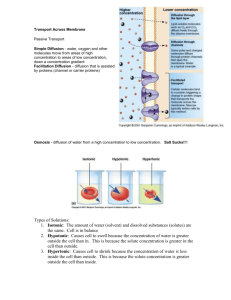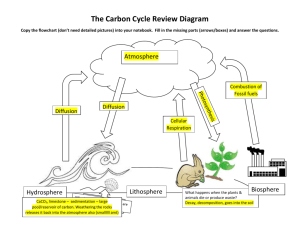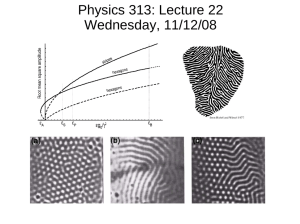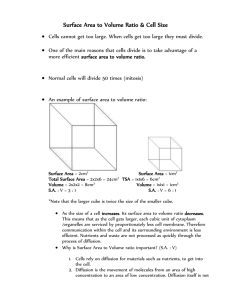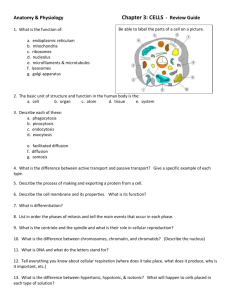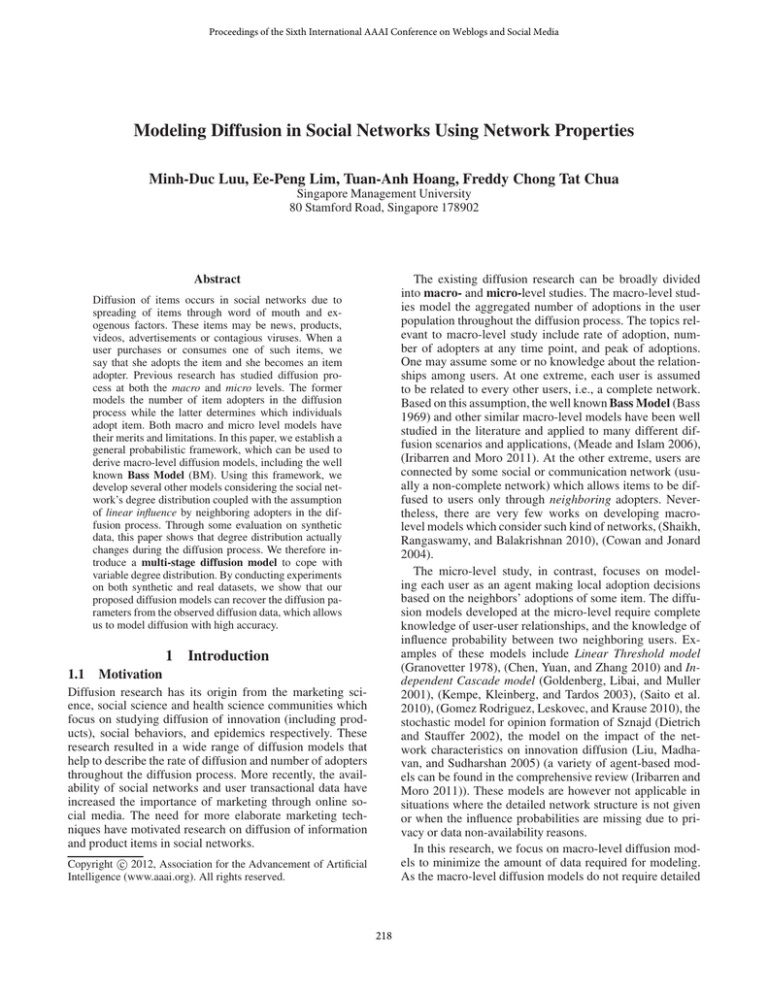
Proceedings of the Sixth International AAAI Conference on Weblogs and Social Media
Modeling Diffusion in Social Networks Using Network Properties
Minh-Duc Luu, Ee-Peng Lim, Tuan-Anh Hoang, Freddy Chong Tat Chua
Singapore Management University
80 Stamford Road, Singapore 178902
Abstract
The existing diffusion research can be broadly divided
into macro- and micro-level studies. The macro-level studies model the aggregated number of adoptions in the user
population throughout the diffusion process. The topics relevant to macro-level study include rate of adoption, number of adopters at any time point, and peak of adoptions.
One may assume some or no knowledge about the relationships among users. At one extreme, each user is assumed
to be related to every other users, i.e., a complete network.
Based on this assumption, the well known Bass Model (Bass
1969) and other similar macro-level models have been well
studied in the literature and applied to many different diffusion scenarios and applications, (Meade and Islam 2006),
(Iribarren and Moro 2011). At the other extreme, users are
connected by some social or communication network (usually a non-complete network) which allows items to be diffused to users only through neighboring adopters. Nevertheless, there are very few works on developing macrolevel models which consider such kind of networks, (Shaikh,
Rangaswamy, and Balakrishnan 2010), (Cowan and Jonard
2004).
The micro-level study, in contrast, focuses on modeling each user as an agent making local adoption decisions
based on the neighbors’ adoptions of some item. The diffusion models developed at the micro-level require complete
knowledge of user-user relationships, and the knowledge of
influence probability between two neighboring users. Examples of these models include Linear Threshold model
(Granovetter 1978), (Chen, Yuan, and Zhang 2010) and Independent Cascade model (Goldenberg, Libai, and Muller
2001), (Kempe, Kleinberg, and Tardos 2003), (Saito et al.
2010), (Gomez Rodriguez, Leskovec, and Krause 2010), the
stochastic model for opinion formation of Sznajd (Dietrich
and Stauffer 2002), the model on the impact of the network characteristics on innovation diffusion (Liu, Madhavan, and Sudharshan 2005) (a variety of agent-based models can be found in the comprehensive review (Iribarren and
Moro 2011)). These models are however not applicable in
situations where the detailed network structure is not given
or when the influence probabilities are missing due to privacy or data non-availability reasons.
In this research, we focus on macro-level diffusion models to minimize the amount of data required for modeling.
As the macro-level diffusion models do not require detailed
Diffusion of items occurs in social networks due to
spreading of items through word of mouth and exogenous factors. These items may be news, products,
videos, advertisements or contagious viruses. When a
user purchases or consumes one of such items, we
say that she adopts the item and she becomes an item
adopter. Previous research has studied diffusion process at both the macro and micro levels. The former
models the number of item adopters in the diffusion
process while the latter determines which individuals
adopt item. Both macro and micro level models have
their merits and limitations. In this paper, we establish a
general probabilistic framework, which can be used to
derive macro-level diffusion models, including the well
known Bass Model (BM). Using this framework, we
develop several other models considering the social network’s degree distribution coupled with the assumption
of linear influence by neighboring adopters in the diffusion process. Through some evaluation on synthetic
data, this paper shows that degree distribution actually
changes during the diffusion process. We therefore introduce a multi-stage diffusion model to cope with
variable degree distribution. By conducting experiments
on both synthetic and real datasets, we show that our
proposed diffusion models can recover the diffusion parameters from the observed diffusion data, which allows
us to model diffusion with high accuracy.
1 Introduction
1.1
Motivation
Diffusion research has its origin from the marketing science, social science and health science communities which
focus on studying diffusion of innovation (including products), social behaviors, and epidemics respectively. These
research resulted in a wide range of diffusion models that
help to describe the rate of diffusion and number of adopters
throughout the diffusion process. More recently, the availability of social networks and user transactional data have
increased the importance of marketing through online social media. The need for more elaborate marketing techniques have motivated research on diffusion of information
and product items in social networks.
c 2012, Association for the Advancement of Artificial
Copyright Intelligence (www.aaai.org). All rights reserved.
218
multi-stage model, which adapts to dynamic degree distribution, in Section 5. For the evaluation of proposed models, the
experiments were conducted and their results are presented
in Section 6. Finally, we conclude our paper in Section 7.
knowledge about network structure, the amount of information required for modeling is small and the number of parameters to be learnt are very few. Our research specifically
addresses the relationship between social network properties and diffusion process. We incorporate the skewed degree distribution of social networks into macro-level diffusion models so that the latter can better explain the diffusion
dynamics among the social network nodes.
1.2
2 Related Work
It is well known (e.g. (Newman 2003)) that most social networks exhibit small world characteristics such as short average path length, the cliquishness, the tendency of containing cliques or near-cliques, and the power-law degree distribution. The impact of these topological features on diffusion has been studied more and more lately. The works by
Cowan (Cowan and Jonard 2004) and Schilling (Schilling
and Phelps 2007) investigated the effect of the first two features, short average path length and the cliquishness, in a
knowledge diffusion system. These works proposed that networks with high clustering and short average path lengths
facilitate much more complete diffusion. Shaikh et al. developed a few macro diffusion models considering the effect of non-uniform internal influence throughout diffusion,
multiple influence by multiple adopters and small world
network property (Shaikh, Rangaswamy, and Balakrishnan
2010). Their proposed models’ performance were empirically compared with BM and some other models using the
Mean Square Error (MSE).
These works however do not consider the degree distribution property of social networks, which is also an essential feature. In the case of infectious diseases, the degree
distribution was proved to have significant effect on their
diffusion. By investigating power-law degree distributions,
(Boguñá, Pastor-Satorras, and Vespignani 2003) proved that
certain kind of these distributions can help disease diffuse
widely. For information diffusion, the work by Nekovee
(Nekovee et al. 2008) proposed a stochastic model for rumor spreading and examined the threshold behavior and dynamics of the model on different kinds of networks (random
graphs, scale-free networks). This work used the mean-field
approach which is similar to ours. However, there are two
points that are essentially different from our work. First of
all, there was no consideration related to the changing topology among non-adopters (termed ignorant nodes in the paper). Secondly, their proposed model also depends on the socalled degree correlation function, which may require more
parameter estimations than our model.
Research Objectives and Contributions
This study aims to develop macro-level diffusion models
that incorporate specific network topology characteristics.
In this paper, we consider only the degree distribution feature of the network and the internal influence due to neighboring nodes. The investigated degree distributions include
the power-law and exponential distribution. In the former,
the probability P (k) of having degree k is proportional to a
constant power of the degree whereas in the latter, P (k) is
proportional to an exponent of the degree. In notations,
1. Power-law distribution:
P (k) ∼ k −α for some constant α.
(1)
2. Exponential distribution:
P (k) ∼ e−k/λ for some constant λ.
(2)
The novel contributions accrued include:
• We proposed two new models, Scale-free network Linear
Influence Model (SLIM) and Exponential network Linear
Influence Model (ELIM) for diffusion in Scale-Free (SF)
and Exponential networks, which follow power-law and
exponential degree distributions respectively. We show
that the mathematical structures of the two diffusion models match the well known Bass model when assuming the
node degree distribution is static during diffusion.
• Through synthetic diffusion data, we observe that the
static degree distribution assumption does not hold as
higher degree nodes are more likely to become adopters
and thus making the node degree distribution more and
more skewed in the later stages of diffusion.
• To circumvent the fitting errors of SLIM and ELIM
due to evolving node degree distribution, we propose
a multi-stage network linear influence model (MLIM)
which adapts the degree distribution parameter in different stages of diffusion. MLIM is shown to produce
smaller fitting errors in our experiments.
1.3
3 Proposed Probabilistic Framework
3.1 General diffusion equation
Outline of Paper
We denote N as the whole population. For each time t,
let f (t) denote the proportion of new adopters at exactly
that time and F (t) denote the cumulative proportion of
adopters up to time t. We denote the event adoption at t
as at , adoption before t as At , no adoption before t as At
and P (adoption at t|no adoption before t) as P (at |At ) for
brevity. Using these notations we define the general framework as follows.
Recall that the function f (t) is the derivative of the func-
The outline of this paper is as follows. In Section 2, we
briefly review related works in macro models. In Section 3,
we establish a generic framework for deriving macro models. From this framework, the Bass Model can be retrieved as
a special case. In order to incorporate the network topology,
we further develop a probabilistic approach which will be
applied to derive two new models, SLIM and ELIM, in Section 4. Since these two models are restricted to the case of
static degree distribution among non-adopters, we propose a
219
tion F (t),
internal influence is proportional to F (t). Hence, the total
adoption probability has the following simple form
dF
f (t) =
(t)
(3)
dt
On the other hand, f (t) is also given by the following
conditional probability,
f (t) =
P (at |At ) = p + q · F (t)
By comparing with (7), the terms p and q · F (t) can be
identified with the terms we · pe and (1 − we ) · Pint (at |At )
respectively.
Substituting (8) into the equation (5), we get
P (at |At )P (At )
=
P (at |At ) (1 − P (At ))
=
P (at |At ) (1 − F (t))
(4)
dF
(t) = (p + q · F (t)) (1 − F (t))
(9)
dt
Equation (9) is a first-order ODE Riccati equation. Hence,
by (Enns and McGuire 2007), it can be solved analytically
to obtain the closed form solution,
Then by equating the R.H.S of the two Equations (3) and
(4), we obtain the following Ordinary Differential Equation
(ODE) for the unknown function F (t)
dF
(t) = P (at |At ) (1 − F (t))
dt
(5)
FBM (t) =
Equation (5) provides a general equation for formulating
various macro diffusion models. The most important component which helps to differentiate between various model
is the adoption probability P (at |At ).
3.2
′
fBM (t) = FBM
(t) =
It is well-known that diffusion is under two kinds of influence, external and internal. The former refers to the influence from mass media on members of the market and the
latter, also known as word-of-mouth (WOM) effect in literature, refers to the influence that adopted users exert on
potential adopters. Upon exerting on a user, these two influences will create two different adoption probabilities, which
are denoted as Pext (at |At ) and Pint (at |At ) respectively.
It is noteworthy that these two influences may have different weights. For instance, a user may have 25% and 75%
chance to be under external and internal influence respectively. Hence, it is reasonable to assign weights we and
1 − we for the external and internal influence respectively.
This argument leads to the following formula for adoption
probability
e(p+q)t
(p + q)2
·
2
p
q
(p+q)t
p +e
(10)
Discussion on Bass Model The simple form of BM leads
to a closed form solution in which the parameters can be
estimated conveniently using any standard least square (LS)
or maximum likelihood (ML) procedures. However, it has
some significant restrictions due to the following issues.
1. The obvious violation of full connectivity assumption in
practical networks with specific degree distributions.
2. The non-uniform WOM effect in the population, which
requires the justification of the form q ·F (t) of internal influence. Empirical data have shown that different persons
in the population receive different influence. In fact, the
influence that each person receives depend on his network
exposure. One of the measures for individuals’ network
exposure is his degree (or out degree), the number of his
friends (in undirected networks) or his followees (in directed networks). This again motivates us to incorporate
degree distribution into our study.
P (at |At ) = we · Pext (at |At ) + (1 − we ) · Pint (at |At ) (6)
It is reasonable to assume that the component adoption probability Pext (at |At ) created by external influence is a constant pe since this influence is stable. Therefore, the above
formula is rewritten as:
3. The possibility of violating the constraint P (at |At ) ≤ 1
due to its linear form. Thus, BM may overfit the empirical data. At this point, the generic form (7) proves its
first advantage over BM, it can guarantee the probabilistic constraint. In fact, it can be seen in (7) that the convex
combination of two quantities Pext (at |At ), Pint (at |At ),
both less than 1, guarantees the constraint.
(7)
By instantiating different Pint (at |At ), we can derive different diffusion models. For Bass Model (BM) with full connectivity assumption, Pint (at |At ) ∼ F (t), which can be
seen in the subsequent section. However, when other network topologies are assumed, the computation of this component is much more complicated. Hence, it will be done
separately in Section 3.4 after BM is reviewed.
3.3
e(p+q)t − 1
e(p+q)t + pq
and
Formulation of adoption probability
P (at |At ) = we · pe + (1 − we ) · Pint (at |At )
(8)
Now that the final issue is already addressed by the generic
form (7), from now on we will focus on the remaining ones,
which depend on computing the component Pint (at |At )
based on topology of the underlying network.
3.4 Modelling Internal Influence
Let us consider a specific social network with a given topology. Since the amount of influence which a user receives
depends on his degree, the probability of adoption due to internal influence will vary along with users’ degree. Hence
Bass Model
Derivation of BM In (Bass 1969), Frank Bass assumed
that the external influence is simply a constant p and the
220
Pint (at |At ) should be replaced by its expected value, which
is taken over the degree distribution of the whole network.
However, for the sake of brevity, the notation Pint (at |At ) is
still used in place of its expected value.
Let the random variables K denote degree of a person
in the network and J be the number of adopters among its
neighbours. J then follows a binomial distribution,
k
P (J = j|K = k) =
F j (1 − Ft )k−j .
(11)
j t
Let x =
By standard manipulations, we have
k X
k
c(1 − Ft )k
jxj
j
j=0
here Ft is used in place of F (t) for brevity.
By the law of total probability, we have
N
−1 X
k
X
= c(1 − Ft )k xk(1 + x)k−1
P (at , k, j|At , aint
t )
(12)
P (at |j, At , aint
t )P (j|k)P (k)
(13)
Pint (at |At ) =
Ft
, the final term will become c ·
1 − Ft
k · Ft , we obtain the required Equation (16).
Upon replacing x =
k=1 j=0
=
N
−1 X
k
X
With this simplification, now we only need to substitute
each of the two specific degree distributions (1), (2) in order
to derive the two corresponding models in the subsequent
sections.
k=1 j=0
Substituting into Equation (13) using the R.H.S of the equation (11), we obtain,
Pint (at |At ) =
N
−1
X
k=1
P (k)
4 Proposed Models for Networks with
Specific Degree Distributions
k
X
4.1 Scale-free Network Linear Influence Model
(SLIM)
j=0
k
j
k−j
(Ft ) (1 − Ft ) P (at |j, At )
j
By (Newman 2003) the precise form for power-law de1
gree distribution is P (k) = ζ(α)
· k −α , where ζ(.) is the
Riemann’s zeta function (c.f (Titchmarsh and Heath-Brown
1986)). Employing the above proposition and substituting
this form, the probability of adoption due to internal influence is rewritten as
(14)
Assuming the degree distribution P (K = k) is known,
we can obtain the formulae for Pint (at |At ) once a specific
form is defined for the term Pint (at |J = j, At ) in (14). This
term is nothing other than the probability of adoption due to
j adopted neighbors. In this work, we assume the simplest
form, Pint (at |J = j, At ) = c · j and then derive the essential component Pint (at |At ) as a function of Ft . For that
derivation, the following technical proposition is needed.
Lemma 1. Assume that the probability of adoption due to j
adopted neighbors is linear i.e.
Pint (at |J = j, At ) = c · j
Ft
, the final expression becomes
1 − Ft
k X
k
k
c(1 − Ft )
jxj
j
j=0
Pint (at |At ) =
N −1
1 X −α
k c · k · Ft
ζ(α)
(17)
N
−1
X
c
Ft
k 1−α
ζ(α)
(18)
k=1
=
k=1
Noticing that the final sum on the RHS is ζ(α−1), we finally
finish the derivation of internal influence as below.
ζ(α − 1)
Pint (at |At ) =
· c · Ft
(19)
ζ(α)
= IC(c, α) · Ft
(20)
(15)
Then we get the following simplified equation
k X
k
(Ft )j (1−Ft )k−j P (at |j, At , aint
t ) = c·k·Ft (16)
j
j=0
ζ(α − 1)
· c, the coefficient of internal
ζ(α)
influence, depends on c and α.
Now that the adoption probability due to internal influence has the simple form given by (20), the total adoption
probability will be
in which IC(c, α) =
Proof. Using the linear form (15), we have
k X
k
j
k−j
(Ft ) (1 − Ft ) Pint (at |j, At )
j
j=0
k X
k
j
k−j
=
(Ft ) (1 − Ft ) c · j
j
j=0
P (at |At ) = we · pe + (1 − we ) · IC(c, α) · Ft
(21)
Substituting this into the general ODE (5) in the framework,
we obtain the following ODE
j
k X
k
Ft
k
= c(1 − Ft )
j
1 − Ft
j
j=0
dF
= [we · pe + (1 − we ) · IC(c, α) · F (t)] (1 − F (t))
dt
(22)
221
By letting p = we · pe and q = (1 − we ) · IC(c, α), we arrive
at the ODE of BM. Thus, it is straightforward to derive the
following main result, the SLIM model.
Then the cumulative adoption fraction F (t) in this network
can be computed by the formula
FELIM (t) =
Proposition 1. Consider the diffusion in an SF network
with power α. Assume that the influence which a node receives from its adopted neighbors is linear, i.e., Pint (at |J =
j, At ) = c · j where c is some constant. Under this assumption, the cumulative adopter fraction F (t) can be computed
by the formula
FSLIM (t) =
e(p+qSLIM )t − 1
qSLIM
e(p+qSLIM )t +
p
4.2
(27)
e(−1/λ)
1 − e(−1/λ)
(28)
where p = we · pe and
qELIM = (1 − we ) · c ·
5 Multi-Stage Macro-level Diffusion
(23)
5.1 Dynamic Degree Distribution
In defining the SLIM and ELIM models, we assume that
the degree distribution under consideration is static throughout diffusion. This assumption unfortunately may not hold.
As diffusion unfolds, the degree distribution of the network
consisting of the remaining non-adopters actually changes.
where p = we · pe , and
qSLIM = (1 − we ) · IC(c, α) = (1 − we )
e(p+qELIM )t − 1
qELIM
e(p+qELIM )t +
p
ζ(α − 1)
· c (24)
ζ(α)
Exponential Network Linear Influence Model
(ELIM)
For this model, the internal influence due to j adopters in
one’s neighbors, Pint (at |Ât , J = j) is still c.j. However,
the underlying network now has an exponential degree distribution. Hence, on computing the adoption probability due
to internal influence, instead of the power-law
form, we sub
stitute the exponential form P (k) = 1 − e(−1/λ) e(−k/λ)
and obtain
Pint (at |At ) =
N
−1 h
X
k=1
k X
k
j
k−j
(Ft ) (1 − Ft ) c.j
j
j=0
Pint (at |At ) = c · Ft ·
N
−1
X
k=1
Let x = e
(−1/λ)
Figure 1: The curves (plotted in linear-log scale) depict
changing degree distributions (among non-adopters) over
time. This was recorded from diffusion on a SF graph G =
(V, E) with |V | = 27289, |E| = 27031, α = 3, pe = 0.1,
we = 0.2, and c = 0.108
i
1 − e(−1/λ) e(−k/λ) ×
(25)
As shown in Figure 1, we examine the degree distribution
of a scale free network consisting of remaining non-adopters
at different time steps (=10,20,30 and 40) with adoptions
synthetically generated. We observe that high degree nodes
are more likely to adopt than low degree ones. Hence,
the proportion of high/low degree nodes decreases/increases
with increasing time steps. This makes the degree distribution among non-adopters more biased towards low degrees.
Figure 1 also reveals that the degree distributions at the later
time points may no longer follow power law. Instead, they
may be more similar to exponential distributions (since the
curves are nearly straight lines in log-linear scale).
Due to this dynamics of degree distribution, SLIM and
ELIM which assume static degree distribution, will not do
well in fitting the observed diffusion data particularly in the
later time steps. To overcome this shortcoming, we propose
to use a multi-stage model.
h
i
k 1 − e(−1/λ) e(−k/λ)
then the final sum is rewritten simply as
c · Ft · (1 − x)
N
−1
X
k · xk
k=1
After some standard manipulations, we obtain
PN −1
Pint (at |At ) = c · Ft · (1 − x) k=1 k · xk
=c·
e(−1/λ)
· Ft
1 − e(−1/λ)
(26)
From this, we can proceed quite the same as SLIM model. In
e(−1/λ)
fact, by letting p = we ·pe and q = (1−we )·c·
,
1 − e(−1/λ)
we also arrive at a Riccati equation and obtain the following
main result for ELIM.
5.2 Multi-Stage Linear Influence Model (MLIM)
The main idea of a multi-stage model is to divide the whole
diffusion period into a series of stages. In the early stages,
which still have degree distribution following power law, we
may fit the observed data using SLIM. For the later stages,
we may fit the observed diffusion data using ELIM.
Proposition 2. Consider a static network whose exponential degree distribution is characterized by parameter λ. The
parameters pe , we , and c are defined as in proposition 1.
222
Assume that the diffusion process is divided into n stages,
[t1 = 0, t2 ), [t2 , t3), . . . , [tn , tn+1 = tmax ]. Now, the parameters we , pe and c are kept constant but the degree distribution function and parameter are allowed to vary in different stages. The exact degree distribution parameter used
depends on the choice of distribution function, i.e., α for
power law and λ for exponential.
For each i-th stage, from time points ti to ti+1 , we use the
following notations:
1-stage
multi-stage
Parameters
pe
we
c
• αi , λi : the parameter of the power-law or exponential degree distribution. In our experiments, we selected the one
that gave the smallest fitting error.
6.2 Dataset Generation
To generate synthetic data, we used Algorithm 1 to simulate diffusion on a default scale free network G = (V, E)
with α=2.5, |V | = 28, 172, |E| = 34, 758. With ground
truth parameters pe , we and c (values provided in Table 2),
this algorithm generates the set of new adopters at each time
step t ∈ [1, tmax] using the linear influence assumption
(see Equation (15)), computes the discrete version f̂t of the
adoption proportion f (t) and updates the set of non-adopters
N A.
With these notations, we can apply exactly the argument
in previous section for stage i and solve for the closed form
of functions Fi (t) and fi (t). The only difference is that the
initial condition F (0) = 0 (for the Riccati ODE) is now
replaced by Fi (ti ) = Fistart , the cumulative adoption proportion at ti observed from data.
Proposition 3. In the i-th stage, the closed forms of functions Fi (t), fi (t) are given by
6.3 Evaluation metrics
(29)
and
fi (t) = fistart ·(pe ·we +qi )2 ·
1 + ∆t
{pe · we + qi + qi · Fistart · ∆t }2
(30)
where
∆t = exp{(pe · we + qi )(t − ti )} − 1
and fistart , the value of fi at ti , is computed from Fistart
using Equation (9), i.e.,
We first evaluate the performance of different models
when the external influence weight changes. We generated
datasets with different we ’s from {0.05, 0.1, 0.2, 0.3, 0.4}.
Other parameters were fixed with default values. For each
we value, ten synthetic dataset instances were generated. We
then applied the different models, i.e., BM and MLIM, to
learn their parameters.
Figure 2(a) shows the average model-fitting error of the
two models over ten dataset instances. We observe that the
multi-stage model (MLIM) always outperformed the 1-stage
model (BM), especially for small we ’s. This can be explained by larger contribution to diffusion from internal influence when we is small. Obviously, this influence is affected a lot by the dynamics of degree distribution among
non-adopters, which is much better modeled by MLIM.
Though not shown in the figure, MLIM also outperformed
6 Experiments
Synthetic Data
In the subsequent experiments, we evaluate our proposed
models and compare them with the well known Bass Model
in modeling diffusion of items within a social network. The
models are divided into two groups: one-stage models and
multi-stage models. For all multi-stage models, the default
number of stages is n = 5. A summary of the parameters is
provided in Table 1. Note that SLIM and ELIM can be derived from BM’s parameters as mentioned in Propositions 1
and 2, they are expected to share identical data fitting errors
as BM. Hence we do not show their results in our experiments.
1
In all experiments, by regressing the function f (t) with its
discrete version f̂t , we learned the parameters pe and αi ’s
(or λi ’s) assuming that c and we were already known. In
this way, we avoid the non-identification problem, i.e. nonuniqueness of solutions, which happens when we learned all
parameters simultaneously. After learning the parameters,
we can evaluate the results based on two metrics: (a) modelfitting error which is the least square error (LSE) between
model and synthetic data, and (b) parameter error which is
the difference between the learned and the ground truth parameter.
6.4 Results with different external influence
weights
fistart = (pe · we + qi · Fistart ) · (1 − Fistart ) .
6.1
Default value
0.1
0.2
5/M axDeg 1
Table 2: Default parameter setting.
• qi : refers to qSLIM or qELIM depending on the choice of
degree distribution function (see Equations (24) and (28)).
pe · we + qi + qi · ∆t
pe · we + qi + qi · Fistart · ∆t
Parameters
p, q
pe , we , c, α
pe , we , c, λ
n, pe , we , c, {αi } (or {λi })
Table 1: Model Parameters.
• Fi (t), fi (t): the functions for cumulative and noncumulative adoption proportions, respectively.
Fi (t) = Fistart ·
Models
BM (baseline)
SLIM
ELIM
MLIM
M axDeg = 78 is the maximum degree of graph G
223
(a) we in {0.05, 0.1, 0.2, 0.3, 0.4}
(b) c in {0.032, 0.064, 0.096, 0.12}
(c) n ∈ {1, 4, 5, 8, 10}
Figure 2: Model-fitting error under different parameter settings: varying we , c or n
BM in learning pe . The average relative pe error of MLIM
and BM were 7.71% and 17.23% respectively.
Algorithm 1: GenerateSynData(G, pe , we , c, tmax)
G = (V, E) graph representing the SF network
the parameters of SLIM
Input : pe , we , c
tmax
the final time of adoption
Output: vector f̂ = (fˆ1 , . . . , fˆtmax ) storing adoption
proportion at different time points.
begin
// At t = 1, initialize randomly a
seed set S of size ⌊pe · we · |V |⌋
ˆ
f1 ← pe · we ;
NA = V \ S ;
// generate diffusion data for
t = 2 → tmax
for t = 2 to tmax do
// update the adoption prob of
each non-adopter
foreach x ∈ N A do
j ← |AdoptedN eighbors(x)| ;
Pint (at |j) ← c · j ;
AdoptP r(x) ← we ·pe +(1−we )·Pint (at |j)
;
end
// determine new adopters using
updated adoption probs
N ewAdopters ← ∅ ;
foreach x ∈ N A do
If AdoptP r(x) > thres then add x to the
set N ewAdopters;
end
// update diffusion data
N A ← N A \ N ewAdopters ;
|N ewAdopters|
fˆt ←
;
|V |
end
return f̂
end
224
6.5 Results with different linear influence
coefficients
We next generated datasets with different coefficients c in
2.5
{i ∗ MaxDeg
, i = 1, 4} = {0.032, 0.064, 0.096, 0.12} using
our default scale free graph. For each c, we also generated
ten dataset instances.
Since increasing c also increases the internal influence,
the effect of increasing c is expected to be similar to that
of decreasing we . Indeed, this expectation is verified by the
results in Figure 2(b). We observe that MLIM again outperforms BM for different c. MLIM could also learn the parameter pe better than BM. The average relative pe error of
MLIM and BM were 3% and 12% respectively.
6.6 Results with different number of stages
For this experiment, n was varied so that we could evaluate
the performance of MLIM over different number of stages.
As shown in Figure 2(c), the more stages, the better MLIM
performs. Moreover, the relative performance difference between one-stage model (BM) to multistage model can be
quite substantial. These observations are reasonable given
that more parameters can be learnt at different stages to fit
the observed data when n is large.
6.7 Experiments on Real Dataset
We conducted experiments on a dataset from GoodReads
(http://www.goodreads.com/), a popular website for recommending and sharing books. GoodReads users have follow
relationships among one another. In this experiment, we
consider a user to have adopted a book when she wrote
review about the book. The GoodReads user network was
collected from Jan 21, 2011 to March 15, 2011. It consists
of nearly 86K users and 159,442 follow links. We selected
20 books which have reviews that span over at least 30
months so as to allow us to observe their diffusion in the
user network. The chosen books are among the most popular ones (e.g. Harry Potter 7, ID=136251; Breaking Dawn,
ID=1162543) so that their diffusion processes are guaranteed to be long and proper enough for our study.
BookId
1162543
14866
1609451
297673
25460
428263
693208
248484
2213661
128029
2248573
1656001
1582996
345627
136251
2767052
30183
3236307
2120932
3777732
Avg
BM
0.001
0.011
0.009
0.011
0.006
0.0002
0.005
0.006
0.007
0.005
0.003
0.002
0.002
0.006
0.0004
0.002
0.002
0.003
0.003
0.002
0.004
M LIM
0.0004
0.007
0.006
0.008
0.005
0.0002
0.004
0.005
0.005
0.004
0.003
0.002
0.002
0.005
0.0003
0.002
0.002
0.003
0.003
0.003
0.003
M LIM
BM
Chen, W.; Yuan, Y.; and Zhang, L. 2010. Scalable influence
maximization in social networks under the linear threshold
model. In Proceedings of the 2010 ICDM, 88–97. IEEE
Computer Society.
Cowan, R., and Jonard, N. 2004. Network structure and the
diffusion of knowledge. Journal of Economic Dynamics and
Control 28(8):1557 – 1575.
Dietrich, and Stauffer. 2002. Sociophysics: the sznajd model
and its applications. Computer Physics Communications
146(1):93 – 98.
Enns, R. H., and McGuire, G. C. 2007. Nonlinear ode models. In Computer Algebra Recipes. Springer New York. 149–
206.
Goldenberg, J.; Libai, B.; and Muller, E. 2001. Talk of the
network: A complex systems look at the underlying process
of word-of-mouth. Marketing Letters 211–223.
Gomez Rodriguez, M.; Leskovec, J.; and Krause, A. 2010.
Inferring networks of diffusion and influence. KDD ’10,
1019–1028. ACM.
Granovetter, M. 1978. Threshold models of collective behavior. American Journal of Sociology 83(5):1420–1443.
Iribarren, J. L., and Moro, E. 2011. Affinity paths and information diffusion in social networks. CoRR abs/1105.3316.
Kempe, D.; Kleinberg, J.; and Tardos, E. 2003. Maximizing
the spread of influence through a social network. In ACM
SIGKDD International Conference on Knowledge Discovery and Data Mining, 137–146.
Liu, B. S.; Madhavan, R.; and Sudharshan, D. 2005. DiffuNET: The impact of network structure on diffusion of
innovation. European Journal of Innovation Management
8(2):240–262.
Meade, N., and Islam, T. 2006. Modelling and forecasting
the diffusion of innovation - a 25-year review. International
Journal of Forecasting 22.
Nekovee, M.; Moreno, Y.; Bianconi, G.; and Marsili, M.
2008. Theory of rumour spreading in complex social networks. CoRR abs/0807.1458.
Newman, M. E. J. 2003. The Structure and Function of
Complex Networks. SIAM Review 45(2):167–256.
Saito, K.; Kimura, M.; Ohara, K.; and Motoda, H. 2010.
Behavioral analyses of information diffusion models by observed data of social network. In SBP, 149–158.
Schilling, M. A., and Phelps, C. C. 2007. Interfirm collaboration networks: The impact of large-scale network structure
on firm innovation. Management Science 53(7):1113–1126.
Shaikh, N. I.; Rangaswamy, A.; and Balakrishnan, A. 2010.
Modeling the diffusion of innovations using small-world
networks. Working paper, Penn State University.
Titchmarsh, E., and Heath-Brown, D. 1986. The theory of
the Riemann zeta-function. Clarendon Press.
0.355
0.623
0.736
0.742
0.771
0.772
0.782
0.792
0.792
0.798
0.807
0.813
0.821
0.884
0.918
0.976
0.989
1.022
1.075
1.176
0.834
Table 3: The second and third column show the fitting error
of corresponding models. The last column shows the ratio of
the two errors.
For this experiment, there were no ground truth parameters. We therefore had to learn all the parameters of the
models. The fitting error results for the 20 selected books
are shown in Table 3. The results show that MLIM performs
better than BM for most books.
7 Conclusions
In this work, we proposed several macro-diffusion models
which incorporate the relationship between diffusion and degree distribution of the underlying network. We developed
two models (SLIM and ELIM) for static degree distribution and one model (MLIM) for dynamic degree distribution
among non-adopters which can be observed in the diffusion
process. Experiments on synthetic data show that the performance of our proposed models is promising for fitting purpose as well as for recovering parameters. The future works
include extending the models to predict diffusion and developing a rigorous way to determine proper degree distribution
(among non-adopters) for each stage in diffusion process.
Acknowledgement
This research is supported by the Singapore National Research Foundation under its International Research Centre @
Singapore Funding Initiative and administered by the IDM
Programme Office.
References
Bass, F. M. 1969. A new product growth for model consumer durables. Management Science 15(5):215–227.
Boguñá, M.; Pastor-Satorras, R.; and Vespignani, A. 2003.
Absence of epidemic threshold in scale-free networks with
degree correlations. Phys. Rev. Lett. 90:028701.
225

